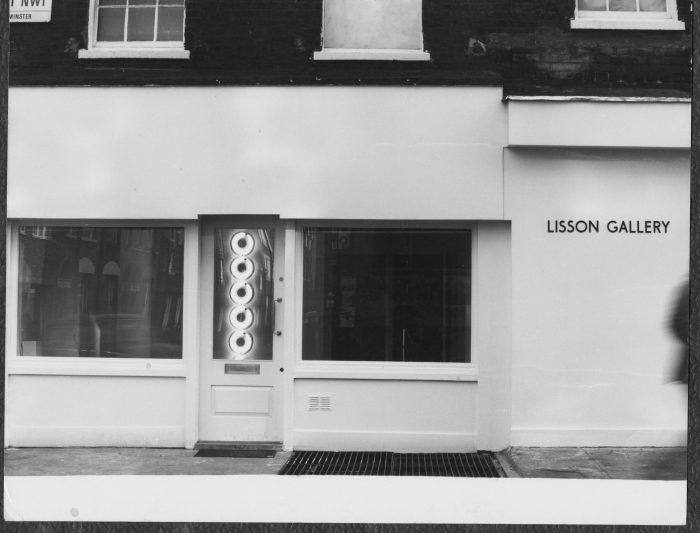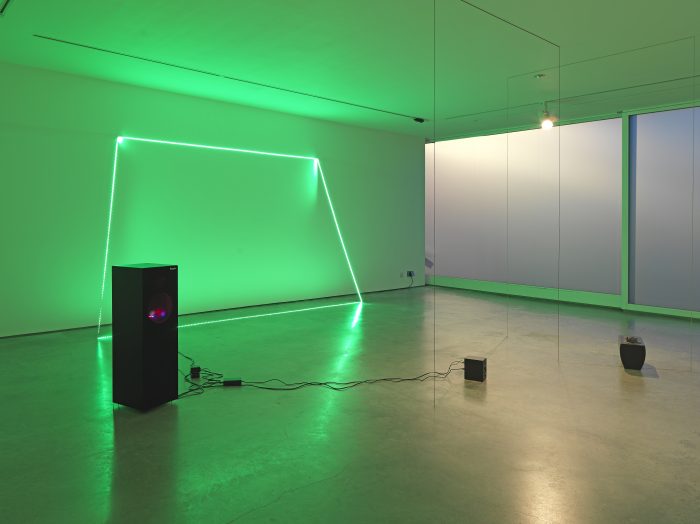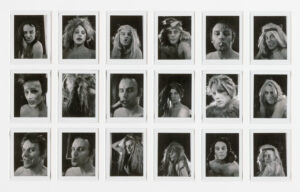
Of all the artworks available for Alex Logsdail to hang above his desk at the New York outpost of Lisson Gallery, he chose a piece by artist Rodney Graham called Good Hand, Bad Hand. The photographic dipytch depicts a mustachioed poker player in a trucker’s hat pulled down low over dark glasses and wearing a blue, floral Hawaiian shirt. In each panel, he sits at a green baize table before identical chip stacks, scrutinizing his cards with a frown. The conceit of the piece is that we can’t know who has which hand, and each, we must assume, is bluffing about the cards he does hold.
It’s almost too perfect an emblem of the art dealer’s position. As in poker, to play the gallery game effectively one must be able to read people without telegraphing one’s own intentions; one must be able to calculate the odds in any transaction and discern your opponents’ motives. It also helps to possess a winning combination of charm and inscrutable reserve. That Logsdail sits beneath it each day says much about the forthrightness of the young gallerist: He has no illusions about his job, nor does he see any point in creating them.
Warm and charismatic while at the same time canny and strategic—I note, for instance, that the chairs across his desk are notably lower than his own— Logsdail has managed one of the toughest tricks in the art business, helping to keep a gallery vital and relevant into its second generation. And though he is the youthful face of the gallery, which celebrates its 50th anniversary this year, the “new phase” Logsdail represents is one during which, he explains, “the gallery has taken on a lot of older artists, people in their seventies or are deceased: Stanley Whitney, Joyce Pensato and the estate of Leon Polk Smith. It’s starting to kind of look backwards.”
That is strangely accurate. As his father, Nicholas tells me, when he started, “the impulse behind gallery was about now, nowness,” whereas the essence of the market in recent years has been older and mid-career artists. Yet when Lisson shifted focus, it was a notably risky strategy; ever-younger emerging artists were all the rage. Lisson upped the ante by declining to chase after the flashiest, most blue-chip mature talents, opting instead to bring in artists like then little-known Carmen Herrera into the family fold—when she was in her early nineties. Working with Herrera, Alex says, “is fascinating because the paintings she’s making now are so fresh that the idea that they would be made by someone who is 102 years old is laughable.”

That against-the-grain individualism is part of the gallery’s DNA. Nicholas founded it, in London, when there was little interest there in new, difficult or international art. As a child in England, he’d been introduced to paintings by his uncle, the writer Roald Dahl, who collected. Nicholas went on to attend the Slade School of Fine Art, with the aim of becoming an artist. Yet, as he tells it, he “started to become disillusioned with the bohemian life. I became very aware that the chances of becoming successful were actually extremely remote, because there were tens of thousands of students in the art schools in Britain at that time.” What was lacking, he realized, were contemporary galleries. With fellow student Derek Jarman, who became a well-known avant-garde filmmaker, the two decided to do something unheard of—mount what today would be called a pop-up show. They chose an unlikely location, on Bell Street in Lisson Grove, where the gallery remains today. Both physically and in terms of sensibility, it was situated far from Cork Street in ultra-posh Mayfair, then the heart of London’s art scene. Artist Dan Graham recalls selecting, “for my first announcement, the typeface and colors of cards that had been distributed in the neighborhood for an escort service.”
Filled with work by Nicholas’s schoolmates, that first show was conspicuously successful. Afterward Jarman said to him, “Well, you’ve got a gallery now. What’s the next show going to be?”

Rather than settling into a pattern of exhibiting work by his friends, Nicholas sought out Continental figures like Blinky Palermo and presented challenging pieces by American Minimalists and Conceptualists. “I was compelled to escape from the stuffy art world of the time,” says Nicholas, “because I had such a passion for understanding what was going on.”
That curiosity resulted in, by his own astute estimation, an “incredible run of shows in the late ’60s and ’70s” with the likes of Donald Judd, Sol Lewitt, Lee Lozano, Dan Graham, Mel Bochner, Carl Andre, Michael Asher, Richard Ryman, Richard Long, Robert Mangold, Victor Burgin and Jo Baer, to name a few. “The gallery became a sort of international secret place,” says Nicholas. “If you were in the know, you knew about it. It was a very hip crowd.” John Lennon attended the opening of a Yoko Ono exhibition during that first year, while their relationship was not yet public.
“I met so many interesting people, and in a sense the gallery came out of that,” says Nicholas. “The gallery made itself.” What he means is that the first generation birthed another, and so on. Among those who attended those early shows were Tony Cragg, Richard Deacon, Anish Kapoor, Shirazeh Houshiary and Julian Opie—all of whom went on to exhibit with Lisson.

Speak with the artists and they’ll tell you that Lisson has retained their loyalty by being, in Haroon Mirza’s words, “consistently committed, correct and open.” For Nicholas, “maintaining a strict regime of paying the artists as soon as we made a sale” has been a point of pride for half a century. But, he admits, it’s a difficult business, one that he certainly never intended his children to get into. “I had a rule with all my kids not to encourage them to join the gallery,” he says. Alex backed into it in much the same way Nicholas did. He’d been studying to be a musician, but, he explains, “I didn’t know if I was good enough to make a living at it without having to make some major compromises.” After cutting his teeth at Artforum and then at Deitch Projects and Team Gallery, he returned to the fold.
An anecdote recounted by artist Liu Xiaodong offers a glimpse of Lisson’s multigenerational mindset. He had a show in Austria, and Alex came to ask him to join Lisson, saying, “Our gallery is not a showroom for big names—we are more like a family, growing together.”
Indeed, the story of Lisson should be seen not as one of relentless expansion, but rather of Nicholas, and now Alex, keeping the clan intact.










 in your life?
in your life?

